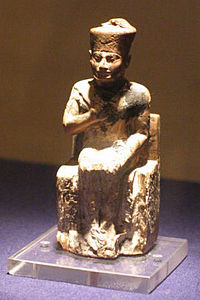Khufu Statuette

Khufu Statuette
|
|
| Material | ivory |
|---|---|
| Size | 7.5 cm high x 2.9 cm long x 2.6 cm deep |
| Created | uncertain: Fourth Dynasty or Twenty-Sixth Dynasty |
| Discovered | Temple of Khentyamentiu, Abydos, Upper Egypt. |
| Present location | Egyptian Museum |
| Identification | JE 36143 |
The Khufu Statuette or the Ivory figurine of Khufu is an Ancient Egyptian statue. Historically and archaeologically significant artifact, it was found in 1903 by Sir William Matthew Flinders Petrie during excavation of Kom el-Sultan in Abydos, Egypt. It depicts the Ancient Egyptian Pharaoh Khufu, a member of the Fourth dynasty (Old Kingdom), and the builder of the Great Pyramid.
To this day, the little seated figure is the only three dimensional depiction of Khufu which survives largely intact, though there are also several statue fragments. Most Egyptologists consider the statue contemporary with Khufu - very likely from his reign. However, because of the unusual provenance, its dating has been repeatedly questioned. The Egyptologist Zahi Hawass even doubts that the statuette dates to the Old Kingdom at all. His argument that the statuette belongs to the 26th Dynasty has not received much credence, but has not yet been refuted. The ritual purpose of the statuette is also unclear. If it was contemporary with Khufu, it was either part of the traditional statue cult or mortuary cult. On the other hand, if the figurine is from a later period, it probably served (as claimed by Hawass) as a votive offering. The statuette's artist is unknown.
The ivory figurine is about 7.5 cm high, 2.9 cm long and c. 2.6 cm wide and partially damaged. Its outer surface was originally smooth and polished to a sheen. The statuette depicts Khufu with the Red crown (deshret) of Lower Egypt. The King sits on a largely undecorated throne with a low back. In his right hand, which is placed over his breast, he holds a flail against his right shoulder with the flail lying over his upper arm. His left arm is bent with his lower arm resting on his left thigh. The left hand is open, with the palm resting on his left knee. His feet have broken away, along with the pedestal. The red crown is damaged – both the ridge at the back and the decorative spiral at the front have broken off. His head is slightly over proportioned relative to his body, with large, projecting ears. His chin is angular and he does not wear the Pharaonic ceremonial beard. The king wears a short, pleated loincloth – his upper body is naked. On the right side, at Khufu's knee is the Horus name "Medjedu" and on the left side of the knee, the very faint traces of the end of his nomen "Khnum-Khufu" is visible in a cartouche.
...
Wikipedia
